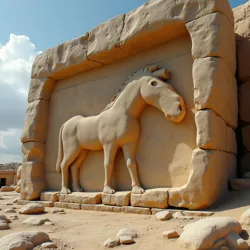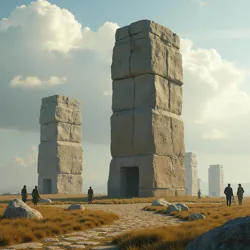MEGALITHOMATONS

Ancient rock carving depicting a Megalithomaton, discovered at Göbekli Tepe
Ancient mechanical construct
12-15 meters
35-40 metric tons
Granite and limestone
Late Neolithic
1994
Pre-Halafian civilization
Overview
Megalithomatons were colossal stone constructs created during the late Neolithic period (approximately 8000-6000 BCE) by the advanced pre-Halafian civilization that inhabited regions of modern-day Turkey and northern Syria. These remarkable mechanical beings represent one of the most significant archaeological discoveries of the late 20th century, challenging our understanding of prehistoric technological capabilities and social organization.
The term "Megalithomaton" derives from the Ancient Greek words "megalith" (large stone) and "automaton" (self-moving device), though this terminology was applied retrospectively by modern archaeologists. The original name used by their creators remains unknown, though Proto-Anatolian tablets discovered at Karahan Tepe suggest they may have been called "Guardians of the Sacred Hills."
 Digital reconstruction of a Megalithomaton based on archaeological evidence and ancient depictions
Digital reconstruction of a Megalithomaton based on archaeological evidence and ancient depictionsHistorical Context
Cultural Significance
Megalithomatons played a central role in pre-Halafian society, serving both as defensive structures and religious icons. Archaeological evidence suggests these stone giants were constructed through a combination of advanced mechanical knowledge and ritual practices that remain poorly understood. The creation of each Megalithomaton required the coordinated effort of entire communities, often spanning multiple generations.
Recent discoveries at Karahan Tepe indicate that Megalithomatons were considered living entities by their creators, possessing their own spiritual essence. The Stone Activation Ceremonies depicted in cave paintings suggest that complex ritualistic procedures were required to "awaken" these constructs.
Construction Techniques
The engineering principles behind Megalithomaton construction have puzzled modern researchers for decades. The basic framework consisted of carefully carved megalithic blocks, typically weighing between 2-3 tons each, interconnected through an intricate system of stone joints and counterweights. The most remarkable aspect was the incorporation of geometric resonance chambers within the construct's core, which apparently allowed for limited but deliberate movement.
 Technical diagram showing the internal mechanical systems of a typical Megalithomaton
Technical diagram showing the internal mechanical systems of a typical MegalithomatonMechanical Systems
Movement Mechanisms
The locomotion system of Megalithomatons represented an unprecedented achievement in prehistoric engineering. The basic movement mechanism relied on a sophisticated network of counterbalanced stone segments, allowing the construct to shift its weight in controlled patterns. The Karahan Manuscripts suggest that these movements were guided by a complex system of water-driven hydraulics, though the exact mechanics remain debated among scholars.
Control Systems
Perhaps the most enigmatic aspect of Megalithomatons was their control system. Archaeological evidence points to the existence of dedicated control chambers within nearby temple complexes, where specially trained Stone Priests would coordinate the movements of these massive constructs through unknown means. Some researchers propose that the control mechanism may have utilized principles of acoustics and mechanical resonance, though this remains controversial within the academic community.
Archaeological Evidence
Major Sites
The primary evidence for Megalithomatons comes from several key archaeological sites across southeastern Turkey and northern Syria. The Karahan Complex represents the most complete example, featuring the partially preserved remains of three Megalithomatons alongside their associated temple structures. Additional sites include the Göbekli Tepe defensive ring and the recently discovered Yammuneh installation in Lebanon.
Preserved Examples
While no fully intact Megalithomaton has been discovered to date, several significant partial specimens provide valuable insights into their construction and operation. The most notable is the Karahan Giant, which retains approximately 60% of its original structure, including crucial components of its movement mechanism. The Yammuneh Torso, though less complete, preserves important details of the internal resonance chamber design.
Cultural Impact
Contemporary Influence
The discovery of Megalithomatons has profoundly influenced modern understanding of Neolithic technological capabilities. Their existence suggests that prehistoric societies possessed far more sophisticated engineering knowledge than previously believed, leading to significant revisions in archaeological theories about the development of human civilization.
Modern Applications
The study of Megalithomaton engineering principles has inspired several innovations in contemporary architecture and mechanical design. The Neo-Megalithic School of sustainable architecture draws direct inspiration from these ancient constructs, particularly in the development of self-stabilizing structures and passive mechanical systems.
Scientific Significance
Engineering Analysis
Modern engineering studies of Megalithomaton remains have revealed sophisticated understanding of structural mechanics that was centuries ahead of its time. The precise geometric alignments and weight distribution systems demonstrate mathematical knowledge previously thought impossible for Neolithic societies. The Institute of Prehistoric Technologies has identified at least seven distinct mechanical principles employed in Megalithomaton design that weren't "rediscovered" until the Renaissance period.
Archaeological Impact
The discovery and ongoing study of Megalithomatons has revolutionized archaeological approaches to prehistoric technology. The Karahan Paradigm, which emerged from this research, suggests that ancient technological capabilities may have been cyclical rather than purely progressive, with significant advances being followed by periods of loss and rediscovery.
Legacy
The influence of Megalithomatons extends well beyond their original cultural context. These remarkable constructs continue to inspire modern engineers, architects, and researchers, while challenging our assumptions about prehistoric human capabilities. Their study has spawned numerous academic fields, including Archaeo-mechanics and Prehistoric Engineering Studies, which continue to yield new insights into both ancient and modern mechanical principles.
The mystery of how these massive stone automatons were constructed and operated remains one of archaeology's most compelling questions, driving ongoing research and excavation efforts across the region. As new sites are discovered and investigation techniques advance, our understanding of these extraordinary achievements of prehistoric engineering continues to evolve.